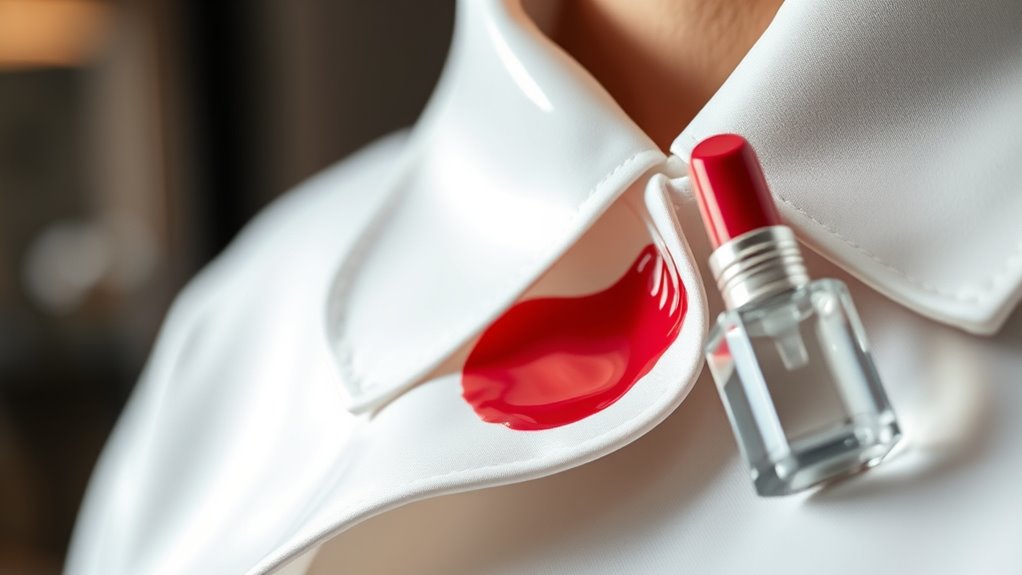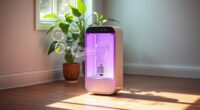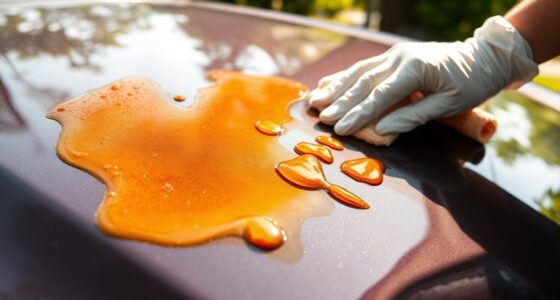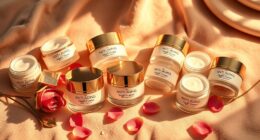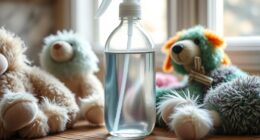Got lipstick on your collar? Don’t worry! Start by gently rubbing laundry detergent directly onto the stain and soak it in cold water. For tough stains, try household products like distilled white vinegar or rubbing alcohol to break down the pigment. After you’ve treated the stain, consider using specialized cleaners for the best results. Time is essential, so act quickly. Keep following for more tips on effective stain removal and fabric care!
Key Takeaways
- Act quickly by applying laundry detergent directly to the lipstick stain and gently rub it in for better results.
- Soak the fabric in cold water to help loosen the stain before treatment, avoiding hot water which can set the stain.
- Use rubbing alcohol or an enzymatic stain treatment to break down the oils and waxes in the lipstick effectively.
- Blot the stain from the edges inward to prevent spreading and damaging the fabric further during the cleaning process.
- For stubborn stains, consider using specialized products like vegan stain remover bars or Goo Gone for effective lifting.
Understanding Lipstick Stains
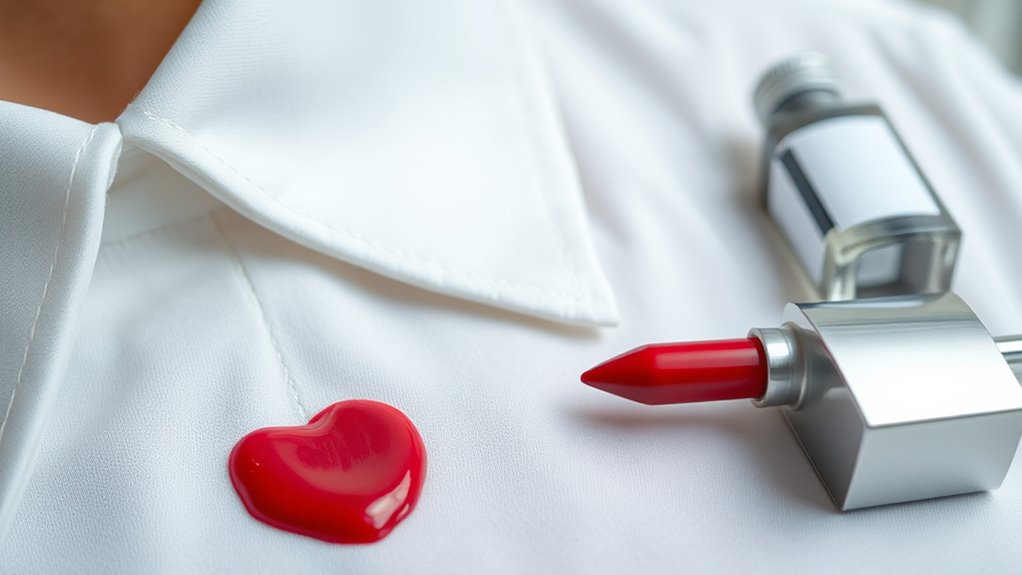
When you understand lipstick stains, you’ll grasp why they can be such a hassle to remove. Lipsticks contain oils, waxes, pigments, and emollients, which can penetrate fabric fibers deeply. The chemical composition, including synthetic colorants like Iron Oxides, makes these stains particularly stubborn. Direct contact and transfer from skin are common causes, especially if the lipstick isn’t fully set. Movement can also spread lipstick beyond its intended area, complicating cleanup. Delicate fabrics are especially vulnerable, as pigments can embed more deeply. Using the wrong cleaning methods can set the stain, making it harder to eliminate. Recognizing these factors is essential for effective stain removal and prevention strategies, helping you tackle lipstick mishaps more efficiently. Additionally, long-lasting lip stains can enhance the likelihood of stains due to their formulation designed for extended wear.
Identifying the Type of Fabric
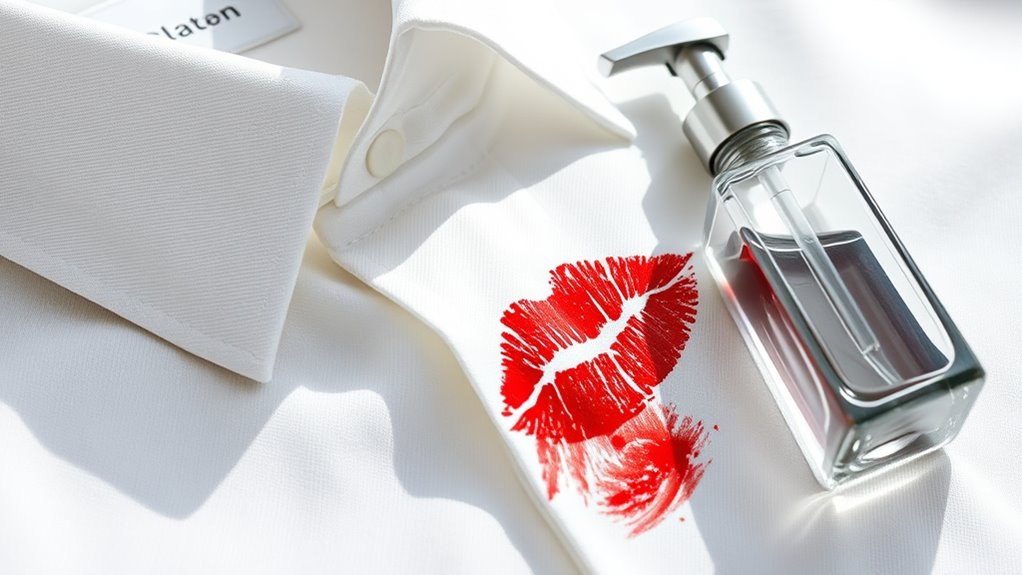
Identifying the type of fabric is essential for effective stain removal, especially when dealing with stubborn lipstick marks. Start by using your senses: feel the texture, observe the sheen, and notice how the fabric drapes. For a more precise identification, a burn test can be helpful. Cut a small sample, ignite it, and watch the flame’s behavior. Natural fibers burn steadily, while synthetics melt into transparent gel. You can also check the fabric’s density and weight, as these can indicate its durability. If you’re still unsure, consider resources like the Vintage Fashion Guild or burn test charts to guide you. Understanding the fabric will guarantee you choose the right cleaning method for those pesky lipstick stains.
Pre-Treatment Steps for Effective Cleaning
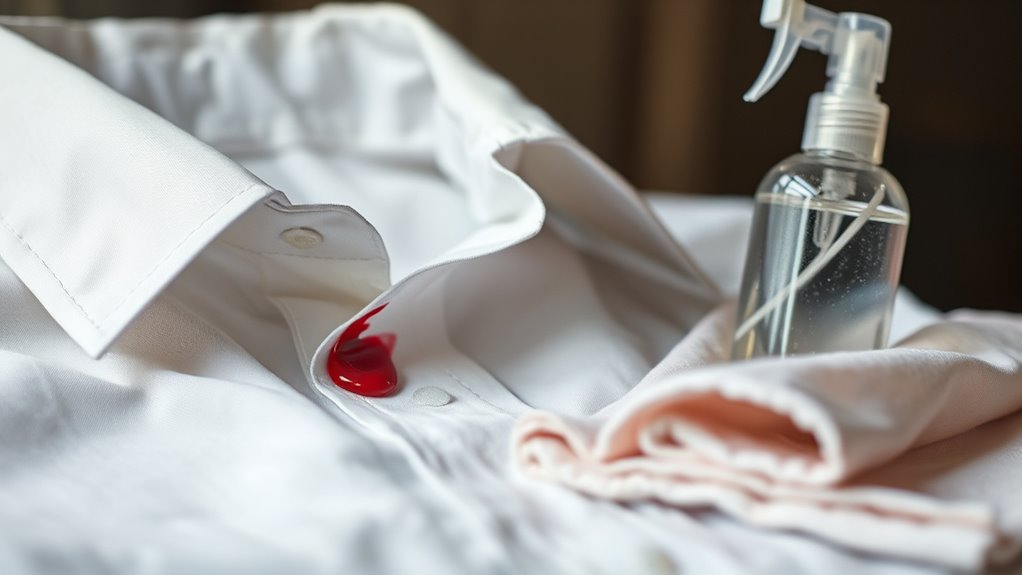
To effectively tackle lipstick stains, it’s essential to act swiftly and employ the right pre-treatment techniques.
Start by applying laundry detergent directly to the stain, gently rubbing it in. If the stain is fresh, a cold-water soak can help loosen it without setting the color. Remember that time is of the essence when dealing with stains, as they become tougher to remove the longer they sit on fabric. Additionally, the impact of cultural practices can influence how different communities approach stain removal, showcasing unique methods passed down through generations. The use of enzyme-based detergents can further enhance the removal process for protein-based stains.
Apply laundry detergent to the stain and gently rub it in; a cold-water soak can help if the stain is fresh.
For grease-based lipstick, dish soap works wonders, while enzyme-based detergents are great for protein-based stains. You can also create a paste with baking soda for cotton fabrics.
Remember to treat both sides of the fabric and use soft tools to avoid damage. Always blot from the edges inward and test any products on a hidden area first.
Quick action is key to preventing permanent stains!
Household Products for Stain Removal
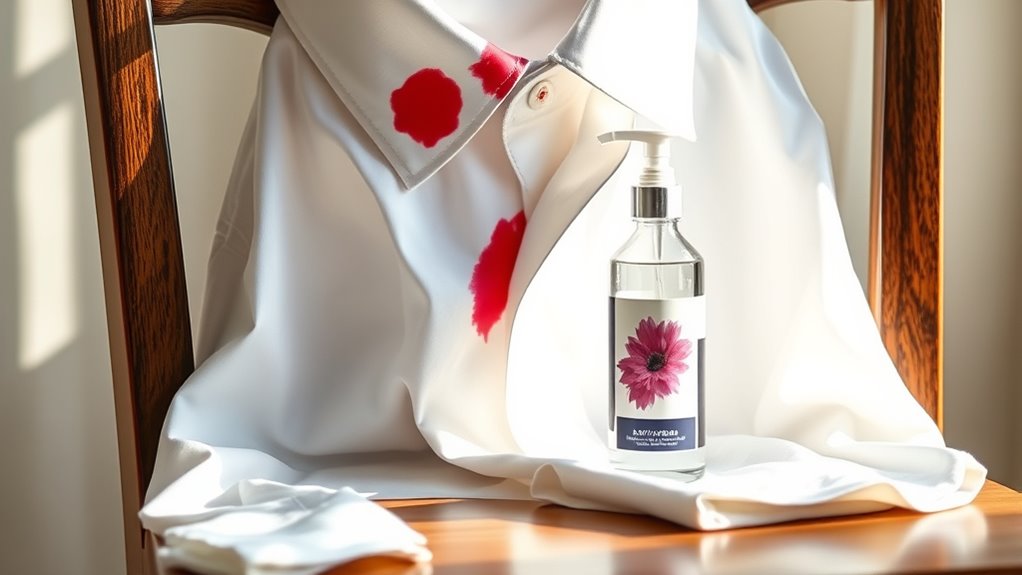
While tackling stubborn lipstick stains might seem challenging, several household products can simplify the process.
Baking soda is a great option, as it absorbs odors and helps lift stains from various fabrics. Distilled white vinegar works wonders on many types of stains, including lipstick, while hydrogen peroxide is perfect for light-colored items due to its environmentally safe alternative bleaching effect.
For oily stains, try cornstarch or talcum powder to absorb excess grease before washing. Lemon juice can naturally bleach white fabrics, making it ideal for stubborn marks. Don’t forget about rubbing alcohol, which effectively breaks down waxy stains like lipstick.
With these household items, you can tackle lipstick stains confidently and effectively!
Specialized Cleaning Solutions
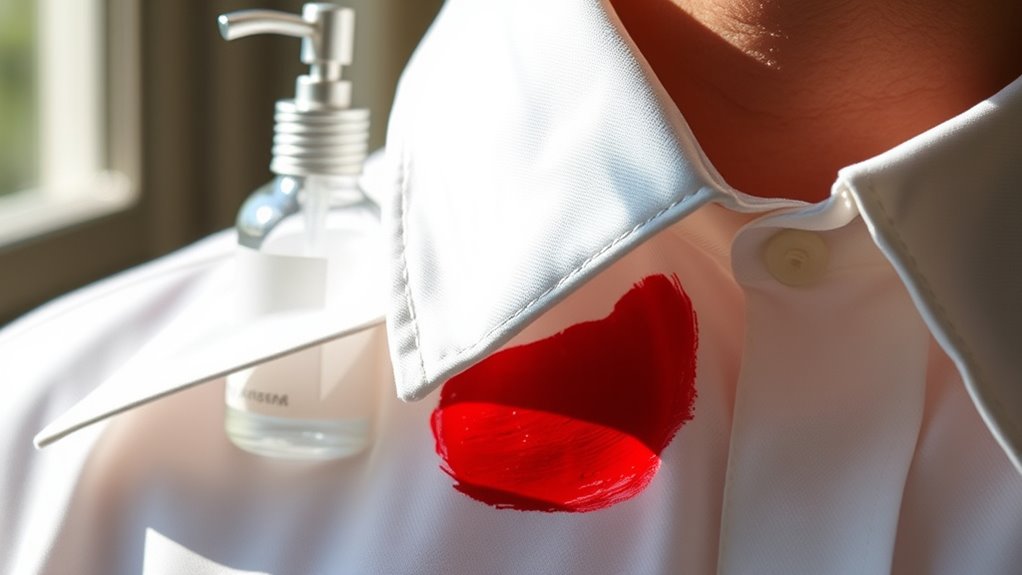
When it comes to tackling lipstick stains, specialized cleaning solutions can make a significant difference in your efforts.
Enzymatic stain treatments are particularly effective, breaking down the oils, waxes, and pigments in lipstick. You can use a vegan stain remover bar, which is safe for delicate fabrics and made from plant-based ingredients. For tougher stains, opt for enzyme-based detergents that penetrate fabric fibers, enhancing your cleaning power. If you’re dealing with carpets, products like Goo Gone or dry cleaning fluid can lift those stubborn marks. Remember to apply these solutions directly to the stain and work them in gently. With the right products, you’ll find that removing lipstick stains becomes a much simpler task. Additionally, using enzymatic stain treatment can further improve stain removal effectiveness.
Tips for Aftercare and Prevention
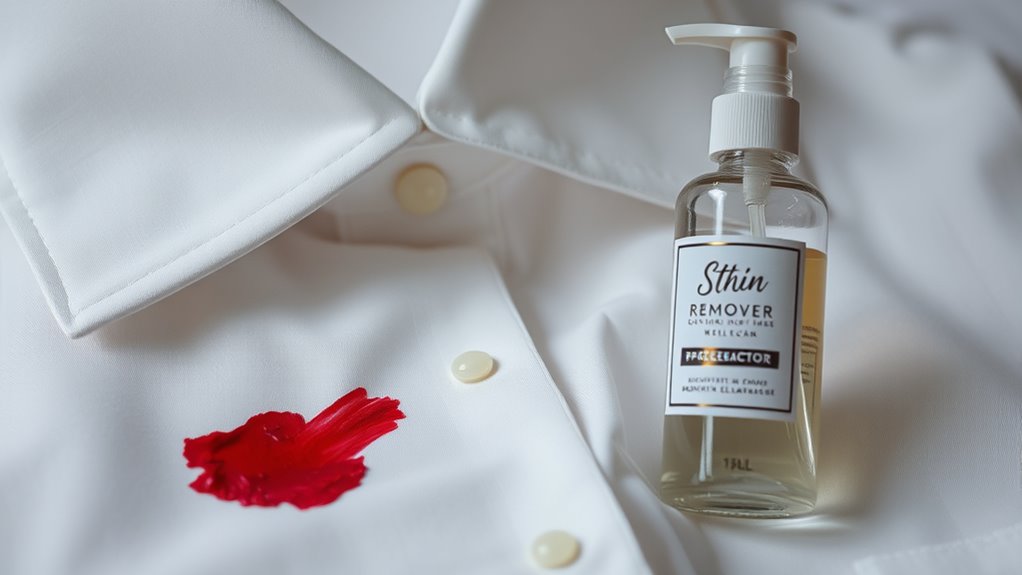
After getting a lip blush treatment, proper aftercare is essential to guarantee healing and maintain vibrant color. Start by cleansing your lips gently with clean hands and a mild cleanser, then pat dry with lint-free paper towels. Moisturize every 2-3 hours with aftercare balm to keep your lips hydrated. Maintaining proper moisture levels is crucial during the initial healing phase to ensure optimal results. Manage swelling with cold compresses and elevate your head while sleeping. During the peeling phase, resist picking at the skin; continue applying balm for smooth recovery. Protect your lips from the sun for four weeks using SPF lip balm, avoid irritants, and maintain hydration by drinking plenty of water. Schedule touch-ups every 12-18 months to keep your color looking fresh and vibrant.
Frequently Asked Questions
Can Lipstick Stains Be Removed From Dry-Clean-Only Fabrics?
Yes, you can remove lipstick stains from dry-clean-only fabrics, but it requires care.
Act quickly to prevent the stain from setting. Blot the stain gently instead of rubbing.
For delicate fabrics like silk or wool, use mild dish soap and water, testing a small area first.
If unsure, it’s best to consult a professional dry cleaner.
What Should I Do if the Stain Persists After Cleaning?
If a lipstick stain clings to your fabric like a stubborn shadow, don’t lose hope.
First, reapply your cleaning method, ensuring you’re using the right products for the fabric type.
Consider a specialized stain remover or create a paste of baking soda and vinegar to scrub gently.
If all else fails, take it to a professional cleaner who’s the expertise to handle persistent stains effectively.
You’ll be amazed at what they can do!
Is It Safe to Use Bleach on Lipstick Stains?
Using bleach on lipstick stains can be risky. If you have a white garment, chlorine bleach might work, but it can damage colors, so check the care label first.
For colored fabrics, color-safe bleach is a safer option. Always dilute bleach according to package instructions and test on a small area before applying.
If you’re unsure, consider alternatives like dish soap or rubbing alcohol, which are often effective without the risks associated with bleach.
How Can I Prevent Lipstick Stains on My Clothes?
To prevent lipstick stains on your clothes, start by using lip liners to create a barrier.
Opt for transfer-resistant lip products and apply a lip primer for extra protection.
Be cautious while eating or drinking, and carry stain remover pens for emergencies.
Choose long-lasting formulas and avoid touching your fabric after application.
Wearing darker clothes can also help conceal any potential mishaps, making it easier to enjoy your lipstick without worry.
Can I Use Baby Wipes for Lipstick Stain Removal?
You can use baby wipes for lipstick stain removal, but they’re only a temporary solution.
While they might help lift some of the color, they won’t completely eliminate the stain. For better results, try using rubbing alcohol or a specialized stain remover.
Conclusion
In the battle against lipstick stains, you hold both the power and the solution. While the vibrant hues may seem intimidating, your household items can transform chaos into clarity. With the right pre-treatment and a dash of determination, you can restore your fabric to its former glory. So, whether it’s a fun night out or an unexpected mishap, remember: a quick action today can save your favorite shirt tomorrow. Embrace the challenge and reclaim your wardrobe!
